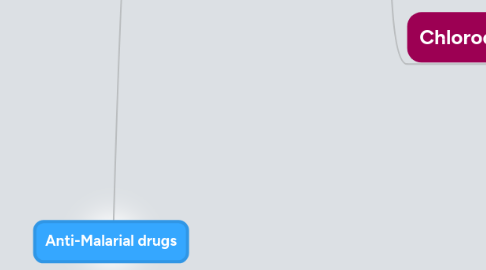
1. Blood schizontocidal drugs (To alleviate symptoms)
1.1. Artemisinin
1.1.1. features
1.1.1.1. imporant because there's no resistance to it yet
1.1.1.2. Fast acting blood blood schizontocide
1.1.2. preparations
1.1.2.1. Artemisinin (T1/2= 4 hrs)
1.1.2.2. Artesunate (t1/2= 45 min)
1.1.2.3. Artemether t1/2= 4-11 hrs)
1.1.2.4. preparations number 2 and 3 is synthestic forms of artemisinin which they are water-soluble becuse artemisinin = poorly soluble
1.1.3. MOA
1.1.3.1. by Production of free radicals which kill the parasites
1.1.4. ADRs
1.1.4.1. Trasniant heart block
1.1.4.2. neutropenia
1.1.4.3. Brief episode of fever
1.1.4.4. neuro hepato and bone toxicity
1.1.4.5. overall the drug is considered safe
1.1.5. Artemisin-Based Combination Therapies [ACTs]
1.1.5.1. Indication of ACTs
1.1.5.1.1. in severe malaria e.g cerebral malaria
1.1.5.1.2. mild to moderate malaria
1.1.5.2. ACTs
1.1.5.2.1. Artemether + lumefantrine
1.1.5.2.2. Artemether + amodiaquine
1.1.5.2.3. Artemether + mefloquine
1.1.5.2.4. Artemether + sulfadoxine-pyrimethamine
1.1.6. Why they should not be used as monotherapy?
1.1.6.1. becuse of its short half life =>
1.1.6.1.1. Recrudescent (recurrence of symptoms)
1.1.6.1.2. resistance
1.2. Chloroquine (in vivax only)
1.2.1. Uses
1.2.1.1. Amebic liver abscess
1.2.1.2. anti-inflammatory action
1.2.1.2.1. Rheumatoid Arthritis
1.2.1.2.2. SLE
1.2.1.3. anti-malarial in acute attack of vivax ONLY! "eradicate blood schizonts of P. vivax"
1.2.1.3.1. because resistanceti it has developed (Choroquine-resistance P. falciparum)
1.2.2. MOA
1.2.2.1. inhibition of Heme polymerase
1.2.2.1.1. when malaria parasite digest host cell's Hb to obtain amino acids, heme also produced which is toxic to the parasite , the parasite detoxifies it by enzyme heme polymerase which convert Heme to Hemozin (nontoxic to the parasite) ,Chloquine inhibit this enzyme accumulation of heme => parasite die.
1.2.2.2. Chloroquine concentratedn1000-fold in food vacules of the parasites, Why?
1.2.2.2.1. ion traping due to low pH.
1.2.2.2.2. active uptake by parasite transporter.
1.2.2.2.3. binding to specific receptor in the food vacule.
1.2.3. ADRs
1.2.3.1. in short-term use
1.2.3.1.1. as in malaria (3 days)
1.2.3.2. prolong Use
1.2.3.2.1. as in Rheumatoid Arthitis
1.2.4. Safe in pregnancy
1.2.5. Chloroquine resistance
1.2.5.1. becuse of increased expression of human Multi Drug Resistance Trasporter P-Glycoprotein (MDR T P-GP) which cause efflux of chloroquine.
1.2.6. Phamacokinetic
1.2.6.1. High volume of distribution
1.2.6.2. concentrated into parasitised RBCs.
1.2.6.3. Released slowly from tissues
1.2.6.4. T 1/2:
1.2.6.4.1. initially
1.2.6.4.2. terminal

